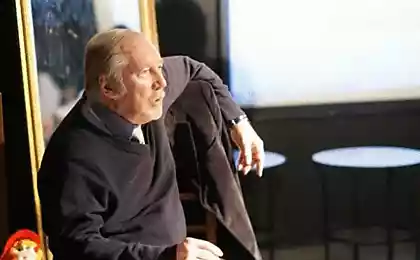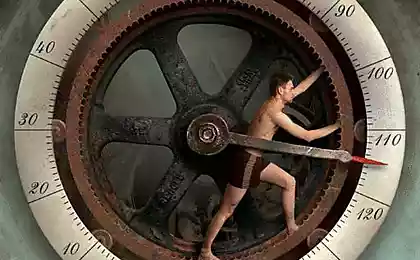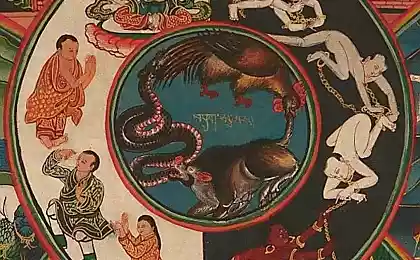641
Life After Death: What Does the Unbiased Science Say About the Soul?
Every person who has faced the death of a loved one wonders whether there is life after death. In our time, this issue is of particular relevance. If a few centuries ago the answer to this question was obvious to all, now, after the period of atheism, the solution is more difficult.
We cannot simply believe the hundreds of generations of our ancestors who, through personal experience, century after century, have been convinced that man has an immortal soul. We want facts. The facts are scientific. They tried to convince us from school that there is no God, no immortal soul. We were told that this is what science says. And we believed... It is believed that there is no immortal soul, believed that science proved this, believed that there is no God. None of us have tried to understand what the unbiased science of the soul says. We simply trusted certain authorities without going into the details of their worldview, objectivity, and interpretations of scientific facts.

Now that tragedy has occurred, there is a conflict within us.
We feel that the soul of the deceased is eternal, that it is alive, but on the other hand, the old and instilled stereotypes that there is no soul drag us into the abyss of despair. This struggle within us is very hard and very exhausting. We want the truth!
So let us look at the question of the existence of the soul through real, non-ideologized, objective science. We will hear the opinion of real scientists on this issue, personally evaluate the logical calculations. It is not our faith in the existence or non-existence of the soul, but only Knowledge that can extinguish this inner conflict, preserve our strength, give confidence, look at the tragedy from a different, real point of view.
The article will focus on consciousness. We will examine the question of Consciousness from the point of view of science: where is Consciousness in our body and can it cease its life?
What is Consciousness?First of all, what consciousness is. People have thought about this issue throughout the history of mankind, but still cannot come to a final decision. We know only some properties, the possibilities of consciousness. Consciousness is the awareness of oneself, one’s personality, it is the great analyzer of all our feelings, emotions, desires, plans. Consciousness is what sets us apart, what makes us feel not as objects but as individuals. In other words, Consciousness miraculously reveals our principled existence. Consciousness is our awareness of our self, but at the same time Consciousness is a great mystery. Consciousness has no dimensions, no shape, no color and smell, no taste, it can not be touched, twisted in the hands. Although we know very little about consciousness, we know for certain that we have it.
One of the main questions of humanity is the question of the nature of this very Consciousness (soul, I, ego). Diameterally opposed views on this subject have materialism and idealism. From the point of view of materialism, human consciousness is the substrate of the brain, the product of matter, the product of biochemical processes, a special fusion of nerve cells. From the point of view of idealism, Consciousness is the ego, the “I”, the spirit, the soul – an immaterial, invisible spiritualizing body, an eternally existing, non-dying energy. In acts of consciousness there is always a subject who is conscious of everything.
If you are interested in purely religious ideas about the soul, then religion will not give any evidence of the existence of the soul. The doctrine of the soul is a dogma and is not subject to scientific proof.
There is absolutely no explanation, much less evidence, for materialists who believe they are impartial scientists (though this is far from the case).
How is it that most people, who are equally far from religion, philosophy, and science, imagine this Consciousness, soul, I? Let us ask ourselves, what is “I”?
Gender, name, profession and other role functions
The first thing that most people think about is: “I am a person”, “I am a woman (man), “I am a businessman (turner, baker),” “I am Tanya (Katya, Alexei)”, “I am a wife (husband, daughter)”, etc. Those are, of course, funny answers. Your individual, unique “I” cannot be defined by general concepts. There are a lot of people with the same characteristics, but they are not your “I”. Half of them are women (men), but they are also not “I”, people with the same professions like have their own, not your “I”, the same can be said about wives (husbands), people of different professions, social status, nationalities, religion, etc. No membership of any group can explain to you what your individual self represents, because Consciousness is always personal. I am not a quality (qualities only belong to our “I”), because the qualities of the same person can change, but his “I” will remain unchanged.
Mental and physiological characteristics
Some say that their “I” is their reflexes, their behavior, their individual ideas and preferences, their psychological characteristics, etc.
In fact, it cannot be the core of a personality called the “I.” Why? Because throughout life, behavior and perceptions and addictions change, and even more so psychological features. It cannot be said that if earlier these features were different, it was not my self.
Realizing this, some make the following argument: “I am my individual body.” That's more interesting. Let's look at that assumption.
Everyone knows from the school anatomy course that the cells of our body are gradually renewed throughout life. The old die (apoptosis), and the new are born. Some cells (the epithelium of the gastrointestinal tract) are completely renewed almost every day, but there are cells that go through their life cycle much longer. On average, every 5 years, all the cells of the body are renewed. If you consider the “I” as a simple collection of human cells, you get absurd. It turns out that if a person lives, for example, 70 years. During this time, at least 10 times a person will change all the cells in his body (i.e. 10 generations). Could this mean that not one person lived a 70-year life, but 10 different people? Isn't that pretty stupid? We conclude that the “I” cannot be the body, because the body is not permanent, and the “I” is permanent.
This means that the “I” cannot be either the qualities of cells or their totality.
But then the especially erudite cite the counterargument: “OK, with bones and muscles it is clear, it really can not be the “I”, but there are nerve cells! They're all alone. Is “I” the sum of nerve cells?
Let’s think about this together...
Is consciousness made up of nerve cells?
Materialism is accustomed to decompose the whole multifaceted world into mechanical components, “to test harmony with algebra.” (A.S. Pushkin). The most naive error of militant materialism with regard to the individual is the idea that the individual is a set of biological qualities. However, the combination of impersonal objects, whether they are atoms or neurons, cannot give rise to the personality and its nucleus, the “I.”
How can this most complex self, feeling, capable of experiencing, be love, just the sum of the specific cells of the body, together with the biochemical and bioelectric processes taking place? How can these processes shape the self? ?
If the nerve cells were our selves, we would lose part of ourselves every day. With every cell that died, with every neuron, the self would become smaller and smaller. With cell repair, it would increase in size.
Scientific studies conducted in different countries of the world prove that nerve cells, like all other cells of the human body, are capable of regeneration. Researchers at the Salk Institute for Biological Research in California have discovered that fully functioning young cells are born in the brains of adult mammals that function on a par with existing neurons. Professor Frederic Gage and colleagues also concluded that brain tissue is most rapidly renewed in physically active animals. 1st
This is confirmed by the publication in another authoritative, peer-reviewed biological journal – Science: Over the past two years, researchers have found that nerve and brain cells are renewed, like the rest in the human body. The body is able to restore disorders related to the nervous tract, says scientist Helen M. Blon.
Thus, even with the complete change of all (including the nerve) cells of the body, the “I” of man remains the same, therefore, it does not belong to the constantly changing material body.
For some reason in our time it is so difficult to prove what was obvious and understandable to the ancients. The third-century Roman Neoplatonist philosopher Plotinus wrote: “It is absurd to suppose that since no part possesses life, life can be created by their totality ... besides, it is absolutely impossible that life should produce a heap of parts, and that the mind should produce that which lacks mind.” If anyone argues that this is not so, but that in fact the soul is formed by atoms that come together, that is, indivisible into parts of the body, he will be refuted by the fact that the atoms themselves only lie next to each other, without forming a living whole, for there can be no unity and joint feeling out of bodies that are insensitive and incapable of uniting; and the soul feels itself. 2.
The self is the unchanging core of the personality that includes many variables but is not itself variable.
The skeptic may make one last desperate argument: “Maybe the ‘I’ is the brain?”
Is consciousness a product of brain activity? What does science say?
The fairy tale that our Consciousness is the activity of the brain, many heard in school. It is an unusually widespread idea that the brain is, in fact, a person with his “I”. Most people think that it is the brain that perceives information from the outside world, processes it and decides how to act in each case, think that it is the brain that makes us alive, gives us personality. And the body is nothing more than a suit, providing the activity of the central nervous system.
But this story has nothing to do with science. The brain is now deeply studied. The chemical composition, parts of the brain, the connections of these departments with human functions have long been well studied. The brain organization of perception, attention, memory, speech is studied. Functional blocks of the brain have been studied. A huge number of clinics and research centers have been studying the human brain for more than a hundred years, for which expensive effective equipment has been developed. But, having opened any textbooks, monographs, scientific journals in neurophysiology or neuropsychology, you will not find scientific data on the connection of the brain with consciousness.
For people far from this field of knowledge, this seems surprising. There's really nothing surprising about that. No one has ever discovered the connection between the brain and the very center of our personality, our self. Of course, materialistic scientists have always wanted this. Thousands of studies and millions of experiments were conducted, many billions of dollars were spent on this. The efforts of scientists were not in vain. Thanks to these studies, the brain regions themselves were discovered and studied, their connection with physiological processes was established, much was done to understand neurophysiological processes and phenomena, but the most important thing was not done. We could not find in the brain the place that is our “I”. It has not been possible, despite very active work in this direction, to make serious assumptions about how the brain can be connected with our Consciousness.
Where did the assumption that consciousness is in the brain come from? This assumption was put forward in the middle of the 18th century by the famous electrophysiologist Dubois-Reymond (1818-1896). In his worldview, Dubois-Reymond was one of the brightest representatives of the mechanistic trend. In one of his letters to a friend, he wrote that “in the body only physical and chemical laws operate; if they can not explain everything, then it is necessary, using physical and mathematical methods, either to find a way of their action, or to accept that there are new forces of matter equal in value to the physical and chemical forces.” 3.
But he did not agree with another outstanding physiologist Carl Friedrich Wilhelm Ludwig (Ludwig, 1816-1895), who lived at the same time as Raymond, who headed in 1869-1895 the new Physiological Institute in Leipzig, which became the largest world center in the field of experimental physiology. The founder of the scientific school, Ludwig wrote that none of the existing theories of nervous activity, including the electrical theory of nerve currents of Dubois-Reymond, can say anything about how acts of sensation are possible due to the activity of nerves. Note that here we are not even talking about the most complex acts of consciousness, but about much simpler sensations. If there is no consciousness, we cannot feel or feel anything.
Another great physiologist of the nineteenth century, the distinguished English neurophysiologist Sir Charles Scott Sherrington, Nobel laureate, said that if it is not clear how the psyche arises from the activity of the brain, then, naturally, it is as little understood how it can have any influence on the behavior of a living being controlled by the nervous system.
Dubois-Reymond concluded, “As we are conscious, we do not know and never will.” And no matter how deep we go into the wilds of intracerebral neurodynamics, we will not throw a bridge into the realm of consciousness. Raymond came to the disappointing conclusion for determinism about the impossibility of explaining Consciousness by material causes. “He admitted that here the human mind is confronted with a ‘world mystery’ that it will never be able to solve.” 4.
Professor of Moscow University, philosopher A.I. Vvedensky in 1914 formulated the law of “the absence of objective signs of animateness”. The meaning of this law is that the role of the psyche in the system of material processes of behavior regulation is absolutely elusive and there is no conceivable bridge between the activity of the brain and the field of psychic or mental phenomena, including Consciousness.
The largest experts in neurophysiology, Nobel laureates David Hubel and Torsten Wiesel recognized that in order to be able to assert the connection between the brain and consciousness, you need to understand what reads and decodes the information that comes from the senses. Scientists have recognized that this is impossible.
The most authoritative scientist, professor of Moscow State University Nikolai Kobozev in his monograph showed that neither cells nor molecules nor even atoms can be responsible for the processes of thinking and memory5.
There is interesting and convincing evidence of the lack of connection between consciousness and the brain, understandable even to people far from science. Here it is:
Suppose that the “I” (Consciousness) is the result of the brain. As neuroscientists know, a person can live even with one hemisphere of the brain. In doing so, he will have consciousness. A person who lives only with the right hemisphere of the brain certainly has an “I” (Consciousness). Accordingly, we can conclude that the “I” is not in the left, absent hemisphere. A person with a single functioning left hemisphere also has an “I”, so the “I” is not in the right hemisphere, which is absent from this person. Consciousness remains regardless of which hemisphere is removed. It means that a person does not have a brain region responsible for consciousness, neither in the left nor in the right hemisphere of the brain. We have to conclude that the presence of consciousness in humans is not associated with certain areas of the brain.
Professor, MD. Voyno-Yasenetsky describes: In a young wounded man I opened a huge abscess (about 50 cubic cm, pus), which undoubtedly destroyed the entire left frontal lobe, and I did not observe any mental defects after this operation. I can say the same about another patient operated on for a huge cyst of the meninges. On the wide opening of the skull, I was surprised to see that almost the entire right half of it was empty, and the entire left hemisphere of the brain was compressed, almost impossible to distinguish it. 6.
In 1940, Dr. Augustine Iturrica made a sensational statement at the Anthropological Society in Sucre, Bolivia. He and Dr. Ortiz studied the medical history of a 14-year-old boy, a patient at Dr. Ortiz's clinic. The teenager was diagnosed with a brain tumor. The young man maintained consciousness until his death, complaining only of a headache. When a postmortem was performed after his death, the doctors were astonished: the entire brain mass was completely separated from the inner cavity of the skull. A large boil captured the cerebellum and part of the brain. It remains unclear how the sick boy’s thinking was preserved.
The fact that consciousness exists independently of the brain is confirmed by research conducted recently by Dutch physiologists led by Pim van Lommel. The results of a large-scale experiment were published in the authoritative biological English journal The Lancet. “Consciousness exists even after the brain has ceased to function. In other words, consciousness “lives” on its own, absolutely on its own. As for the brain, it is not thinking matter at all, but an organ, like any other, performing strictly defined functions. Very possibly, thinking matter, even in principle, does not exist, said the head of the study, the famous scientist Pim van Lommel 7.
Another argument accessible to the understanding of non-experts leads Professor V.F. Voino-Yasenetsky: “In the wars of ants without a brain, deliberateness is clearly revealed, and therefore reasonableness, no different from human.” 8. It's a really amazing fact. Ants solve quite complex problems of survival, housing, providing themselves with food, i.e. have a certain intelligence, but do not have a brain at all. Makes you wonder, doesn't it?
Neurophysiology does not stand still, but is one of the most dynamically developing sciences. The methods and scale of research are used to study the functions, parts of the brain, its composition is clarified in more detail. Despite the titanic work on the study of the brain, world science today is also far from understanding what creativity, thinking, memory and what their relationship with the brain itself is.
What is the nature of Consciousness?
Having come to understand that there is no Consciousness inside the body, science draws natural conclusions about the immaterial nature of consciousness.
Academician P.K. Anokhin: None of the “thinking” operations that we attribute to “mind” has been directly linked to any part of the brain. If, in principle, we cannot understand exactly how the psychic arises from the activity of the brain, is it not more logical to think that the psyche is not in its essence a function of the brain, but represents the manifestation of some other immaterial spiritual forces? 9.
At the end of the XX century, the creator of quantum mechanics, Nobel laureate E. Schrödinger wrote that the nature of the connection of certain physical processes with subjective events (to which consciousness belongs) lies “away from science and beyond human understanding.”
The largest modern neurophysiologist, Nobel Prize laureate in medicine J. Eccles developed the idea that it is impossible to determine the origin of psychic phenomena from the analysis of brain activity, and this fact can easily be interpreted in the sense that the psyche is not a function of the brain at all. Neither physiology nor evolution can shed light on the origin and nature of consciousness, which is completely alien to all material processes in the universe. The spiritual world of man and the world of physical realities, including brain activity, are completely independent worlds that only interact and influence each other to some extent. He is echoed by such major experts as Carl Leshley (American scientist, director of the laboratory of primate biology in Orange Park (Florida), who studied the mechanisms of the brain) and Harvard University doctor Edward Tolman.
With his colleague, the founder of modern neurosurgery, Wilder Penfield, who performed more than 10,000 operations on the brain, Eccles wrote the book The Mystery of Man 10. In it, the authors explicitly state that “there is no doubt that a person is governed by something outside his body.” "I can experimentally confirm," Eccles writes, "that the workings of consciousness cannot be explained by the functioning of the brain." Consciousness exists independently of it from without.”
According to Eccles, consciousness cannot be the subject of scientific research. The emergence of consciousness, as well as the emergence of life, is the highest religious secret. In his report, the Nobel laureate relied on the conclusions of the book “Personality and the Brain”, written together with the American philosopher-sociologist Karl Popper.
Wilder Penfield, after many years of studying brain activity, also came to the conclusion that “the energy of the mind is different from the energy of brain neural impulses.” 11.
Academician of the Academy of Medical Sciences of the Russian Federation, Director of the Research Institute of the Brain (RAMS RF), a world-renowned neurophysiologist, professor, Doctor of Medicine Natalia Petrovna Bekhtereva: The hypothesis that the human brain only perceives thoughts from somewhere outside, I first heard from the lips of the Nobel laureate, Professor John Eccles. Of course, then it seemed absurd to me. But then studies conducted at our St. Petersburg Brain Research Institute confirmed that we cannot explain the mechanics of the creative process. The brain can generate only the simplest thoughts, such as turning the pages of a book or disturbing the sugar in a glass. And the creative process is a manifestation of a completely new quality. As a believer, I accept God’s participation in the management of the thought process.12
Science is gradually coming to the conclusion that the brain is not the source of thought and consciousness, but at most its retransmitter.
As Professor S. Grof puts it: “Imagine that your TV broke down and you called a telemaster, who twisted different hands and set it up.” It does not occur to you that all these stations are sitting in this box.13
Back in 1956, the outstanding major scientist-surgeon, Doctor of Medical Sciences, Professor V.F. Voyno-Yasenetsky believed that our brain is not only not connected with Consciousness, but even unable to think independently, since the mental process is beyond its limits. In his book, Valentin Felixovich argues that “the brain is not an organ of thought, senses”, and that “the spirit acts outside the brain, determining its activity, and all our being, when the brain works as a transmitter, receiving signals and transmitting them to the organs of the body” 14.
The same conclusions were reached by English researchers Peter Fenwick from the London Institute of Psychiatry and Sam Parnia from the Central Hospital of Southampton. They examined patients who had returned to life after cardiac arrest and found that some of them accurately recounted the content of conversations that medical staff conducted while they were in a state of clinical death. Others gave an accurate description of what happened during this time period. Sam Parnia argues that the brain, like any other organ in the human body, is made up of cells and cannot think. However, it can work as a device that detects thoughts, i.e., as an antenna with which it becomes possible to receive a signal from the outside. Scientists have suggested that during clinical death, consciousness acting independently of the brain uses it as a screen. Like a television receiver that first receives the waves that hit it, and then converts them into sound and image.
Turning off the radio does not mean that the radio station stops broadcasting. That is, after the death of the physical body, consciousness continues to live.
The fact of continuing the life of Consciousness after the death of the body is confirmed by the academician of the RAMS, director of the Research Institute of the Human Brain, Professor N.P. Bekhtereva in his book “The Magic of the Brain and the Labyrinths of Life”. In addition to discussing purely scientific problems, in this book the author also gives his personal experience of collision with posthumous phenomena.
Natalia Bekhtereva, speaking about a meeting with the Bulgarian clairvoyant Vanga Dimitrova, quite definitely speaks about this in one of her interviews: “The example of Vanga absolutely convinced me that there is a phenomenon of contact with the dead”, and another quote from her book: “I cannot but believe what I heard and saw myself.” A scientist has no right to reject facts (if he is a scientist!) just because they do not fit into a dogma, a worldview.12
The first consistent description of postmortem life, based on scientific observations, was given by the Swedish scientist and naturalist Emmanuel Swedenborg. Then this problem was seriously studied by the famous psychiatrist Elizabeth Kubler Ross, no less famous psychiatrist Raymond Moody, conscientious scientists academicians Oliver Lodge15,16, William Crookes17, Alfred Wallace, Alexander Butlerov, Professor Friedrich Myers18, American pediatrician Melvin Morse. Among the serious and systematic researchers of the issue of dying, one should mention the professor of medicine at Emory University and the staff doctor at the hospital for veterans in Atlanta, Dr. Michael Sabom, a systematic study of psychiatrist Kenneth Ring is also very valuable, Dr. Moritz Raolings, a resuscitation physician, our contemporary, thanatopsychologist A. A. Nalchajian, studied this problem. He worked a lot on understanding this problem from the point of view of physics, the famous Soviet scientist, the largest specialist in the field of thermodynamic processes, a member of the Academy of Sciences of the Republic of Belarus Albert Veynik. A significant contribution to the study of near-death experience was made by the world-famous American psychologist of Czech origin, the founder of the transpersonal school of psychology, Dr. Stanislav Grof.
The variety of facts accumulated by science proves indisputably that after physical death, each of the living now inherits a different reality, preserving his Consciousness.
Despite the limitations of our ability to understand this reality with the help of material means, today there are a number of its characteristics obtained through the experiments and observations of scientists investigating this problem.
These characteristics were listed by A.V. Mikheev, a researcher at the St. Petersburg State Electrotechnical University in his report at the International Symposium “Life After Death: From Belief to Knowledge” held on April 8-9, 2005 in St. Petersburg:
1. There is a so-called “subtle body”, which is the carrier of self-consciousness, memory, emotions and “inner life” of a person. This body exists after physical death, being for the duration of the existence of the physical body its “parallel component”, providing the above processes. The physical body is only a medium for their manifestation on the physical (earthly) level.
2. The life of the individual does not end with the present earthly death. Survival after death is a natural law for man.
3. The following reality is divided into a large number of levels, differing in the frequency characteristics of their components.
4. The place of a person in the posthumous transition is determined by his adjustment to a certain level, which is the total result of his thoughts, feelings and actions during life on Earth. Just as the spectrum of electromagnetic radiation emitted by a chemical depends on its composition, so the posthumous location of a person is determined by the “component characteristic” of his inner life.
5. The concepts of heaven and hell reflect two polarities, possible post-mortem states.
6. In addition to such polar states, there are a number of intermediate states. The choice of an adequate state is automatically determined by the mental-emotional “pattern” formed by a person during earthly life. That is why negative emotions, violence, the desire for destruction and fanaticism, whatever they may be justified outwardly, in this respect are extremely destructive for the future fate of a person. This is a strong case for personal responsibility and ethical principles. 19.
All of the above arguments coincide with the religious knowledge of all traditional religions. This is a reason to cast doubts and decide. Isn't it?
Author: Mikhail Hasminsky
1. Cell polarity: From embryo to axon, Nature Magazine. 27.08. 2003. Vol. 421, no. 6926. P 905-906 Melissa M. Rolls and Chris Q. Doe
2. Dam. Enneads. Treatises 1-11., The Greek-Latin Cabinet by Y. A. Shichalin, Moscow, 2007.
3. Du Bois-Reymond E. Gesammelte Abhandlungen zur allgemeinen Muskel- und Nervenphysik. Bd. 1.
Leipzig: Veit & Co., 1875. P. 102
4. Du Bois-Reymond, E. Gesammelte Abhandlungen zur allgemeinen Muskel- und Nervenphysik. Bd. 1. P.87
5. Kobozev N. I. Research in the field of thermodynamics of information and thinking processes. M.: Moscow State University, 1971. P. 85.
6, Voyno-Yasenetsky V. F. Spirit, soul and body. CJSC "Brovary printing house", 2002. P. 43.
7. Near-death experience in survivors of cardiac arrest: a prospective study in the Netherlands; Dr Pirn van Lommel MD, Ruud van Wees PhD, Vincent Meyers PhD, Ingrid Elfferich PhD // The Lancet. Dec 2001 2001. Vol 358. No. 9298 P. 2039-2045.
8. Voyno-Yasenetsky V. F. Spirit, soul and body. CJSC "Brovary printing house", 2002 P. 36.
9/ Anokhin P.K. System mechanisms of higher nervous activity. Selected works. Moscow, 1979, p. 455.
10. Eccles J. The Human Mystery.
Berlin: Springer 1979. P. 176.
11. Penfield W. The Mystery of the Mind.
Princeton, 1975. P. 25-27
12. I was blessed to study the mirror. Interview of N.P. Bekhtereva to the newspaper “Volga Pravda”, March 19, 2005.
13. Grof S. Holotropic Consciousness. The three levels of human consciousness and their impact on our lives. M: AST; Ganga, 2002. P. 267.
14. Voyno-Yasenetsky V. F. Spirit, soul and body. CJSC "Brovary printing house", 2002 P.45.
15. Lodge O. Raymond, or life and death.
London 1916
16. Lodge O. The survival of man.
London 1911
17. Crookes, W. Researches in the phenomena of spiritualism.
London, 1926 P. 24
18. Myers. Human personality and its survival of bodily death.
London, year 1sted.1903 P. 68
19. Mikheev A. V. Life after death: from faith to knowledge
Journal "Consciousness and Physical Reality", No. 6, 2005 and in the abstracts of the international symposium "Noospheric Innovations in Culture, Education, Science, Technology, Healthcare", April 8-9, 2005, St. Petersburg.
Source: www.memoriam.ru/sushhestvuet-li-dusha-i-bessmertno-li-soznanie
We cannot simply believe the hundreds of generations of our ancestors who, through personal experience, century after century, have been convinced that man has an immortal soul. We want facts. The facts are scientific. They tried to convince us from school that there is no God, no immortal soul. We were told that this is what science says. And we believed... It is believed that there is no immortal soul, believed that science proved this, believed that there is no God. None of us have tried to understand what the unbiased science of the soul says. We simply trusted certain authorities without going into the details of their worldview, objectivity, and interpretations of scientific facts.

Now that tragedy has occurred, there is a conflict within us.
We feel that the soul of the deceased is eternal, that it is alive, but on the other hand, the old and instilled stereotypes that there is no soul drag us into the abyss of despair. This struggle within us is very hard and very exhausting. We want the truth!
So let us look at the question of the existence of the soul through real, non-ideologized, objective science. We will hear the opinion of real scientists on this issue, personally evaluate the logical calculations. It is not our faith in the existence or non-existence of the soul, but only Knowledge that can extinguish this inner conflict, preserve our strength, give confidence, look at the tragedy from a different, real point of view.
The article will focus on consciousness. We will examine the question of Consciousness from the point of view of science: where is Consciousness in our body and can it cease its life?
What is Consciousness?First of all, what consciousness is. People have thought about this issue throughout the history of mankind, but still cannot come to a final decision. We know only some properties, the possibilities of consciousness. Consciousness is the awareness of oneself, one’s personality, it is the great analyzer of all our feelings, emotions, desires, plans. Consciousness is what sets us apart, what makes us feel not as objects but as individuals. In other words, Consciousness miraculously reveals our principled existence. Consciousness is our awareness of our self, but at the same time Consciousness is a great mystery. Consciousness has no dimensions, no shape, no color and smell, no taste, it can not be touched, twisted in the hands. Although we know very little about consciousness, we know for certain that we have it.
One of the main questions of humanity is the question of the nature of this very Consciousness (soul, I, ego). Diameterally opposed views on this subject have materialism and idealism. From the point of view of materialism, human consciousness is the substrate of the brain, the product of matter, the product of biochemical processes, a special fusion of nerve cells. From the point of view of idealism, Consciousness is the ego, the “I”, the spirit, the soul – an immaterial, invisible spiritualizing body, an eternally existing, non-dying energy. In acts of consciousness there is always a subject who is conscious of everything.
If you are interested in purely religious ideas about the soul, then religion will not give any evidence of the existence of the soul. The doctrine of the soul is a dogma and is not subject to scientific proof.
There is absolutely no explanation, much less evidence, for materialists who believe they are impartial scientists (though this is far from the case).
How is it that most people, who are equally far from religion, philosophy, and science, imagine this Consciousness, soul, I? Let us ask ourselves, what is “I”?
Gender, name, profession and other role functions
The first thing that most people think about is: “I am a person”, “I am a woman (man), “I am a businessman (turner, baker),” “I am Tanya (Katya, Alexei)”, “I am a wife (husband, daughter)”, etc. Those are, of course, funny answers. Your individual, unique “I” cannot be defined by general concepts. There are a lot of people with the same characteristics, but they are not your “I”. Half of them are women (men), but they are also not “I”, people with the same professions like have their own, not your “I”, the same can be said about wives (husbands), people of different professions, social status, nationalities, religion, etc. No membership of any group can explain to you what your individual self represents, because Consciousness is always personal. I am not a quality (qualities only belong to our “I”), because the qualities of the same person can change, but his “I” will remain unchanged.
Mental and physiological characteristics
Some say that their “I” is their reflexes, their behavior, their individual ideas and preferences, their psychological characteristics, etc.
In fact, it cannot be the core of a personality called the “I.” Why? Because throughout life, behavior and perceptions and addictions change, and even more so psychological features. It cannot be said that if earlier these features were different, it was not my self.
Realizing this, some make the following argument: “I am my individual body.” That's more interesting. Let's look at that assumption.
Everyone knows from the school anatomy course that the cells of our body are gradually renewed throughout life. The old die (apoptosis), and the new are born. Some cells (the epithelium of the gastrointestinal tract) are completely renewed almost every day, but there are cells that go through their life cycle much longer. On average, every 5 years, all the cells of the body are renewed. If you consider the “I” as a simple collection of human cells, you get absurd. It turns out that if a person lives, for example, 70 years. During this time, at least 10 times a person will change all the cells in his body (i.e. 10 generations). Could this mean that not one person lived a 70-year life, but 10 different people? Isn't that pretty stupid? We conclude that the “I” cannot be the body, because the body is not permanent, and the “I” is permanent.
This means that the “I” cannot be either the qualities of cells or their totality.
But then the especially erudite cite the counterargument: “OK, with bones and muscles it is clear, it really can not be the “I”, but there are nerve cells! They're all alone. Is “I” the sum of nerve cells?
Let’s think about this together...
Is consciousness made up of nerve cells?
Materialism is accustomed to decompose the whole multifaceted world into mechanical components, “to test harmony with algebra.” (A.S. Pushkin). The most naive error of militant materialism with regard to the individual is the idea that the individual is a set of biological qualities. However, the combination of impersonal objects, whether they are atoms or neurons, cannot give rise to the personality and its nucleus, the “I.”
How can this most complex self, feeling, capable of experiencing, be love, just the sum of the specific cells of the body, together with the biochemical and bioelectric processes taking place? How can these processes shape the self? ?
If the nerve cells were our selves, we would lose part of ourselves every day. With every cell that died, with every neuron, the self would become smaller and smaller. With cell repair, it would increase in size.
Scientific studies conducted in different countries of the world prove that nerve cells, like all other cells of the human body, are capable of regeneration. Researchers at the Salk Institute for Biological Research in California have discovered that fully functioning young cells are born in the brains of adult mammals that function on a par with existing neurons. Professor Frederic Gage and colleagues also concluded that brain tissue is most rapidly renewed in physically active animals. 1st
This is confirmed by the publication in another authoritative, peer-reviewed biological journal – Science: Over the past two years, researchers have found that nerve and brain cells are renewed, like the rest in the human body. The body is able to restore disorders related to the nervous tract, says scientist Helen M. Blon.
Thus, even with the complete change of all (including the nerve) cells of the body, the “I” of man remains the same, therefore, it does not belong to the constantly changing material body.
For some reason in our time it is so difficult to prove what was obvious and understandable to the ancients. The third-century Roman Neoplatonist philosopher Plotinus wrote: “It is absurd to suppose that since no part possesses life, life can be created by their totality ... besides, it is absolutely impossible that life should produce a heap of parts, and that the mind should produce that which lacks mind.” If anyone argues that this is not so, but that in fact the soul is formed by atoms that come together, that is, indivisible into parts of the body, he will be refuted by the fact that the atoms themselves only lie next to each other, without forming a living whole, for there can be no unity and joint feeling out of bodies that are insensitive and incapable of uniting; and the soul feels itself. 2.
The self is the unchanging core of the personality that includes many variables but is not itself variable.
The skeptic may make one last desperate argument: “Maybe the ‘I’ is the brain?”
Is consciousness a product of brain activity? What does science say?
The fairy tale that our Consciousness is the activity of the brain, many heard in school. It is an unusually widespread idea that the brain is, in fact, a person with his “I”. Most people think that it is the brain that perceives information from the outside world, processes it and decides how to act in each case, think that it is the brain that makes us alive, gives us personality. And the body is nothing more than a suit, providing the activity of the central nervous system.
But this story has nothing to do with science. The brain is now deeply studied. The chemical composition, parts of the brain, the connections of these departments with human functions have long been well studied. The brain organization of perception, attention, memory, speech is studied. Functional blocks of the brain have been studied. A huge number of clinics and research centers have been studying the human brain for more than a hundred years, for which expensive effective equipment has been developed. But, having opened any textbooks, monographs, scientific journals in neurophysiology or neuropsychology, you will not find scientific data on the connection of the brain with consciousness.
For people far from this field of knowledge, this seems surprising. There's really nothing surprising about that. No one has ever discovered the connection between the brain and the very center of our personality, our self. Of course, materialistic scientists have always wanted this. Thousands of studies and millions of experiments were conducted, many billions of dollars were spent on this. The efforts of scientists were not in vain. Thanks to these studies, the brain regions themselves were discovered and studied, their connection with physiological processes was established, much was done to understand neurophysiological processes and phenomena, but the most important thing was not done. We could not find in the brain the place that is our “I”. It has not been possible, despite very active work in this direction, to make serious assumptions about how the brain can be connected with our Consciousness.
Where did the assumption that consciousness is in the brain come from? This assumption was put forward in the middle of the 18th century by the famous electrophysiologist Dubois-Reymond (1818-1896). In his worldview, Dubois-Reymond was one of the brightest representatives of the mechanistic trend. In one of his letters to a friend, he wrote that “in the body only physical and chemical laws operate; if they can not explain everything, then it is necessary, using physical and mathematical methods, either to find a way of their action, or to accept that there are new forces of matter equal in value to the physical and chemical forces.” 3.
But he did not agree with another outstanding physiologist Carl Friedrich Wilhelm Ludwig (Ludwig, 1816-1895), who lived at the same time as Raymond, who headed in 1869-1895 the new Physiological Institute in Leipzig, which became the largest world center in the field of experimental physiology. The founder of the scientific school, Ludwig wrote that none of the existing theories of nervous activity, including the electrical theory of nerve currents of Dubois-Reymond, can say anything about how acts of sensation are possible due to the activity of nerves. Note that here we are not even talking about the most complex acts of consciousness, but about much simpler sensations. If there is no consciousness, we cannot feel or feel anything.
Another great physiologist of the nineteenth century, the distinguished English neurophysiologist Sir Charles Scott Sherrington, Nobel laureate, said that if it is not clear how the psyche arises from the activity of the brain, then, naturally, it is as little understood how it can have any influence on the behavior of a living being controlled by the nervous system.
Dubois-Reymond concluded, “As we are conscious, we do not know and never will.” And no matter how deep we go into the wilds of intracerebral neurodynamics, we will not throw a bridge into the realm of consciousness. Raymond came to the disappointing conclusion for determinism about the impossibility of explaining Consciousness by material causes. “He admitted that here the human mind is confronted with a ‘world mystery’ that it will never be able to solve.” 4.
Professor of Moscow University, philosopher A.I. Vvedensky in 1914 formulated the law of “the absence of objective signs of animateness”. The meaning of this law is that the role of the psyche in the system of material processes of behavior regulation is absolutely elusive and there is no conceivable bridge between the activity of the brain and the field of psychic or mental phenomena, including Consciousness.
The largest experts in neurophysiology, Nobel laureates David Hubel and Torsten Wiesel recognized that in order to be able to assert the connection between the brain and consciousness, you need to understand what reads and decodes the information that comes from the senses. Scientists have recognized that this is impossible.
The most authoritative scientist, professor of Moscow State University Nikolai Kobozev in his monograph showed that neither cells nor molecules nor even atoms can be responsible for the processes of thinking and memory5.
There is interesting and convincing evidence of the lack of connection between consciousness and the brain, understandable even to people far from science. Here it is:
Suppose that the “I” (Consciousness) is the result of the brain. As neuroscientists know, a person can live even with one hemisphere of the brain. In doing so, he will have consciousness. A person who lives only with the right hemisphere of the brain certainly has an “I” (Consciousness). Accordingly, we can conclude that the “I” is not in the left, absent hemisphere. A person with a single functioning left hemisphere also has an “I”, so the “I” is not in the right hemisphere, which is absent from this person. Consciousness remains regardless of which hemisphere is removed. It means that a person does not have a brain region responsible for consciousness, neither in the left nor in the right hemisphere of the brain. We have to conclude that the presence of consciousness in humans is not associated with certain areas of the brain.
Professor, MD. Voyno-Yasenetsky describes: In a young wounded man I opened a huge abscess (about 50 cubic cm, pus), which undoubtedly destroyed the entire left frontal lobe, and I did not observe any mental defects after this operation. I can say the same about another patient operated on for a huge cyst of the meninges. On the wide opening of the skull, I was surprised to see that almost the entire right half of it was empty, and the entire left hemisphere of the brain was compressed, almost impossible to distinguish it. 6.
In 1940, Dr. Augustine Iturrica made a sensational statement at the Anthropological Society in Sucre, Bolivia. He and Dr. Ortiz studied the medical history of a 14-year-old boy, a patient at Dr. Ortiz's clinic. The teenager was diagnosed with a brain tumor. The young man maintained consciousness until his death, complaining only of a headache. When a postmortem was performed after his death, the doctors were astonished: the entire brain mass was completely separated from the inner cavity of the skull. A large boil captured the cerebellum and part of the brain. It remains unclear how the sick boy’s thinking was preserved.
The fact that consciousness exists independently of the brain is confirmed by research conducted recently by Dutch physiologists led by Pim van Lommel. The results of a large-scale experiment were published in the authoritative biological English journal The Lancet. “Consciousness exists even after the brain has ceased to function. In other words, consciousness “lives” on its own, absolutely on its own. As for the brain, it is not thinking matter at all, but an organ, like any other, performing strictly defined functions. Very possibly, thinking matter, even in principle, does not exist, said the head of the study, the famous scientist Pim van Lommel 7.
Another argument accessible to the understanding of non-experts leads Professor V.F. Voino-Yasenetsky: “In the wars of ants without a brain, deliberateness is clearly revealed, and therefore reasonableness, no different from human.” 8. It's a really amazing fact. Ants solve quite complex problems of survival, housing, providing themselves with food, i.e. have a certain intelligence, but do not have a brain at all. Makes you wonder, doesn't it?
Neurophysiology does not stand still, but is one of the most dynamically developing sciences. The methods and scale of research are used to study the functions, parts of the brain, its composition is clarified in more detail. Despite the titanic work on the study of the brain, world science today is also far from understanding what creativity, thinking, memory and what their relationship with the brain itself is.
What is the nature of Consciousness?
Having come to understand that there is no Consciousness inside the body, science draws natural conclusions about the immaterial nature of consciousness.
Academician P.K. Anokhin: None of the “thinking” operations that we attribute to “mind” has been directly linked to any part of the brain. If, in principle, we cannot understand exactly how the psychic arises from the activity of the brain, is it not more logical to think that the psyche is not in its essence a function of the brain, but represents the manifestation of some other immaterial spiritual forces? 9.
At the end of the XX century, the creator of quantum mechanics, Nobel laureate E. Schrödinger wrote that the nature of the connection of certain physical processes with subjective events (to which consciousness belongs) lies “away from science and beyond human understanding.”
The largest modern neurophysiologist, Nobel Prize laureate in medicine J. Eccles developed the idea that it is impossible to determine the origin of psychic phenomena from the analysis of brain activity, and this fact can easily be interpreted in the sense that the psyche is not a function of the brain at all. Neither physiology nor evolution can shed light on the origin and nature of consciousness, which is completely alien to all material processes in the universe. The spiritual world of man and the world of physical realities, including brain activity, are completely independent worlds that only interact and influence each other to some extent. He is echoed by such major experts as Carl Leshley (American scientist, director of the laboratory of primate biology in Orange Park (Florida), who studied the mechanisms of the brain) and Harvard University doctor Edward Tolman.
With his colleague, the founder of modern neurosurgery, Wilder Penfield, who performed more than 10,000 operations on the brain, Eccles wrote the book The Mystery of Man 10. In it, the authors explicitly state that “there is no doubt that a person is governed by something outside his body.” "I can experimentally confirm," Eccles writes, "that the workings of consciousness cannot be explained by the functioning of the brain." Consciousness exists independently of it from without.”
According to Eccles, consciousness cannot be the subject of scientific research. The emergence of consciousness, as well as the emergence of life, is the highest religious secret. In his report, the Nobel laureate relied on the conclusions of the book “Personality and the Brain”, written together with the American philosopher-sociologist Karl Popper.
Wilder Penfield, after many years of studying brain activity, also came to the conclusion that “the energy of the mind is different from the energy of brain neural impulses.” 11.
Academician of the Academy of Medical Sciences of the Russian Federation, Director of the Research Institute of the Brain (RAMS RF), a world-renowned neurophysiologist, professor, Doctor of Medicine Natalia Petrovna Bekhtereva: The hypothesis that the human brain only perceives thoughts from somewhere outside, I first heard from the lips of the Nobel laureate, Professor John Eccles. Of course, then it seemed absurd to me. But then studies conducted at our St. Petersburg Brain Research Institute confirmed that we cannot explain the mechanics of the creative process. The brain can generate only the simplest thoughts, such as turning the pages of a book or disturbing the sugar in a glass. And the creative process is a manifestation of a completely new quality. As a believer, I accept God’s participation in the management of the thought process.12
Science is gradually coming to the conclusion that the brain is not the source of thought and consciousness, but at most its retransmitter.
As Professor S. Grof puts it: “Imagine that your TV broke down and you called a telemaster, who twisted different hands and set it up.” It does not occur to you that all these stations are sitting in this box.13
Back in 1956, the outstanding major scientist-surgeon, Doctor of Medical Sciences, Professor V.F. Voyno-Yasenetsky believed that our brain is not only not connected with Consciousness, but even unable to think independently, since the mental process is beyond its limits. In his book, Valentin Felixovich argues that “the brain is not an organ of thought, senses”, and that “the spirit acts outside the brain, determining its activity, and all our being, when the brain works as a transmitter, receiving signals and transmitting them to the organs of the body” 14.
The same conclusions were reached by English researchers Peter Fenwick from the London Institute of Psychiatry and Sam Parnia from the Central Hospital of Southampton. They examined patients who had returned to life after cardiac arrest and found that some of them accurately recounted the content of conversations that medical staff conducted while they were in a state of clinical death. Others gave an accurate description of what happened during this time period. Sam Parnia argues that the brain, like any other organ in the human body, is made up of cells and cannot think. However, it can work as a device that detects thoughts, i.e., as an antenna with which it becomes possible to receive a signal from the outside. Scientists have suggested that during clinical death, consciousness acting independently of the brain uses it as a screen. Like a television receiver that first receives the waves that hit it, and then converts them into sound and image.
Turning off the radio does not mean that the radio station stops broadcasting. That is, after the death of the physical body, consciousness continues to live.
The fact of continuing the life of Consciousness after the death of the body is confirmed by the academician of the RAMS, director of the Research Institute of the Human Brain, Professor N.P. Bekhtereva in his book “The Magic of the Brain and the Labyrinths of Life”. In addition to discussing purely scientific problems, in this book the author also gives his personal experience of collision with posthumous phenomena.
Natalia Bekhtereva, speaking about a meeting with the Bulgarian clairvoyant Vanga Dimitrova, quite definitely speaks about this in one of her interviews: “The example of Vanga absolutely convinced me that there is a phenomenon of contact with the dead”, and another quote from her book: “I cannot but believe what I heard and saw myself.” A scientist has no right to reject facts (if he is a scientist!) just because they do not fit into a dogma, a worldview.12
The first consistent description of postmortem life, based on scientific observations, was given by the Swedish scientist and naturalist Emmanuel Swedenborg. Then this problem was seriously studied by the famous psychiatrist Elizabeth Kubler Ross, no less famous psychiatrist Raymond Moody, conscientious scientists academicians Oliver Lodge15,16, William Crookes17, Alfred Wallace, Alexander Butlerov, Professor Friedrich Myers18, American pediatrician Melvin Morse. Among the serious and systematic researchers of the issue of dying, one should mention the professor of medicine at Emory University and the staff doctor at the hospital for veterans in Atlanta, Dr. Michael Sabom, a systematic study of psychiatrist Kenneth Ring is also very valuable, Dr. Moritz Raolings, a resuscitation physician, our contemporary, thanatopsychologist A. A. Nalchajian, studied this problem. He worked a lot on understanding this problem from the point of view of physics, the famous Soviet scientist, the largest specialist in the field of thermodynamic processes, a member of the Academy of Sciences of the Republic of Belarus Albert Veynik. A significant contribution to the study of near-death experience was made by the world-famous American psychologist of Czech origin, the founder of the transpersonal school of psychology, Dr. Stanislav Grof.
The variety of facts accumulated by science proves indisputably that after physical death, each of the living now inherits a different reality, preserving his Consciousness.
Despite the limitations of our ability to understand this reality with the help of material means, today there are a number of its characteristics obtained through the experiments and observations of scientists investigating this problem.
These characteristics were listed by A.V. Mikheev, a researcher at the St. Petersburg State Electrotechnical University in his report at the International Symposium “Life After Death: From Belief to Knowledge” held on April 8-9, 2005 in St. Petersburg:
1. There is a so-called “subtle body”, which is the carrier of self-consciousness, memory, emotions and “inner life” of a person. This body exists after physical death, being for the duration of the existence of the physical body its “parallel component”, providing the above processes. The physical body is only a medium for their manifestation on the physical (earthly) level.
2. The life of the individual does not end with the present earthly death. Survival after death is a natural law for man.
3. The following reality is divided into a large number of levels, differing in the frequency characteristics of their components.
4. The place of a person in the posthumous transition is determined by his adjustment to a certain level, which is the total result of his thoughts, feelings and actions during life on Earth. Just as the spectrum of electromagnetic radiation emitted by a chemical depends on its composition, so the posthumous location of a person is determined by the “component characteristic” of his inner life.
5. The concepts of heaven and hell reflect two polarities, possible post-mortem states.
6. In addition to such polar states, there are a number of intermediate states. The choice of an adequate state is automatically determined by the mental-emotional “pattern” formed by a person during earthly life. That is why negative emotions, violence, the desire for destruction and fanaticism, whatever they may be justified outwardly, in this respect are extremely destructive for the future fate of a person. This is a strong case for personal responsibility and ethical principles. 19.
All of the above arguments coincide with the religious knowledge of all traditional religions. This is a reason to cast doubts and decide. Isn't it?
Author: Mikhail Hasminsky
1. Cell polarity: From embryo to axon, Nature Magazine. 27.08. 2003. Vol. 421, no. 6926. P 905-906 Melissa M. Rolls and Chris Q. Doe
2. Dam. Enneads. Treatises 1-11., The Greek-Latin Cabinet by Y. A. Shichalin, Moscow, 2007.
3. Du Bois-Reymond E. Gesammelte Abhandlungen zur allgemeinen Muskel- und Nervenphysik. Bd. 1.
Leipzig: Veit & Co., 1875. P. 102
4. Du Bois-Reymond, E. Gesammelte Abhandlungen zur allgemeinen Muskel- und Nervenphysik. Bd. 1. P.87
5. Kobozev N. I. Research in the field of thermodynamics of information and thinking processes. M.: Moscow State University, 1971. P. 85.
6, Voyno-Yasenetsky V. F. Spirit, soul and body. CJSC "Brovary printing house", 2002. P. 43.
7. Near-death experience in survivors of cardiac arrest: a prospective study in the Netherlands; Dr Pirn van Lommel MD, Ruud van Wees PhD, Vincent Meyers PhD, Ingrid Elfferich PhD // The Lancet. Dec 2001 2001. Vol 358. No. 9298 P. 2039-2045.
8. Voyno-Yasenetsky V. F. Spirit, soul and body. CJSC "Brovary printing house", 2002 P. 36.
9/ Anokhin P.K. System mechanisms of higher nervous activity. Selected works. Moscow, 1979, p. 455.
10. Eccles J. The Human Mystery.
Berlin: Springer 1979. P. 176.
11. Penfield W. The Mystery of the Mind.
Princeton, 1975. P. 25-27
12. I was blessed to study the mirror. Interview of N.P. Bekhtereva to the newspaper “Volga Pravda”, March 19, 2005.
13. Grof S. Holotropic Consciousness. The three levels of human consciousness and their impact on our lives. M: AST; Ganga, 2002. P. 267.
14. Voyno-Yasenetsky V. F. Spirit, soul and body. CJSC "Brovary printing house", 2002 P.45.
15. Lodge O. Raymond, or life and death.
London 1916
16. Lodge O. The survival of man.
London 1911
17. Crookes, W. Researches in the phenomena of spiritualism.
London, 1926 P. 24
18. Myers. Human personality and its survival of bodily death.
London, year 1sted.1903 P. 68
19. Mikheev A. V. Life after death: from faith to knowledge
Journal "Consciousness and Physical Reality", No. 6, 2005 and in the abstracts of the international symposium "Noospheric Innovations in Culture, Education, Science, Technology, Healthcare", April 8-9, 2005, St. Petersburg.
Source: www.memoriam.ru/sushhestvuet-li-dusha-i-bessmertno-li-soznanie
This natural phenomenon takes hundreds of lives each year, but few know about it
Solar plane Sunseeker Duo is flying through the Alps - and back























